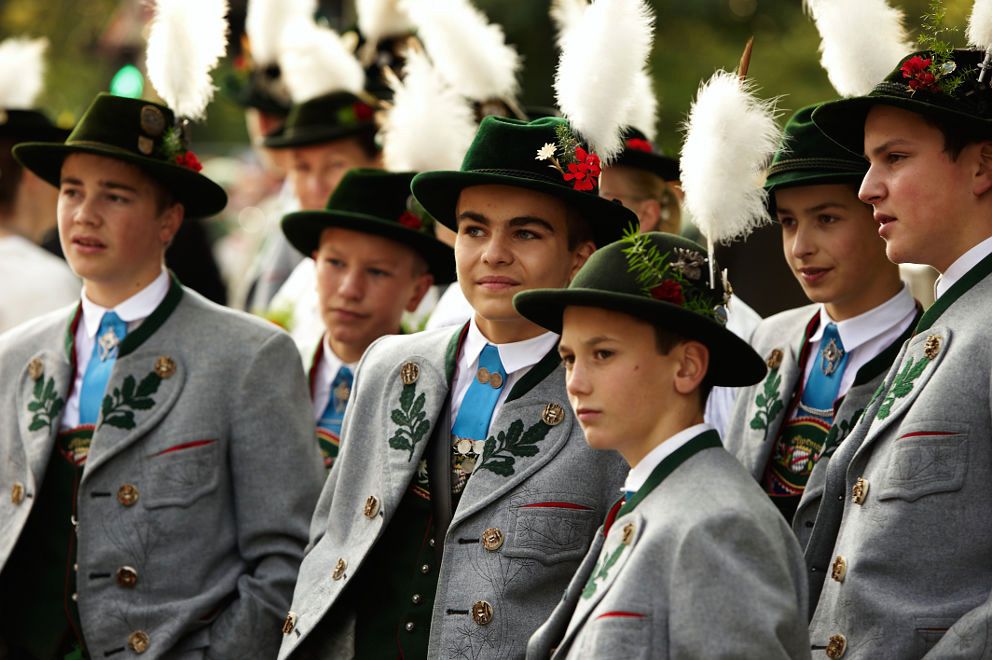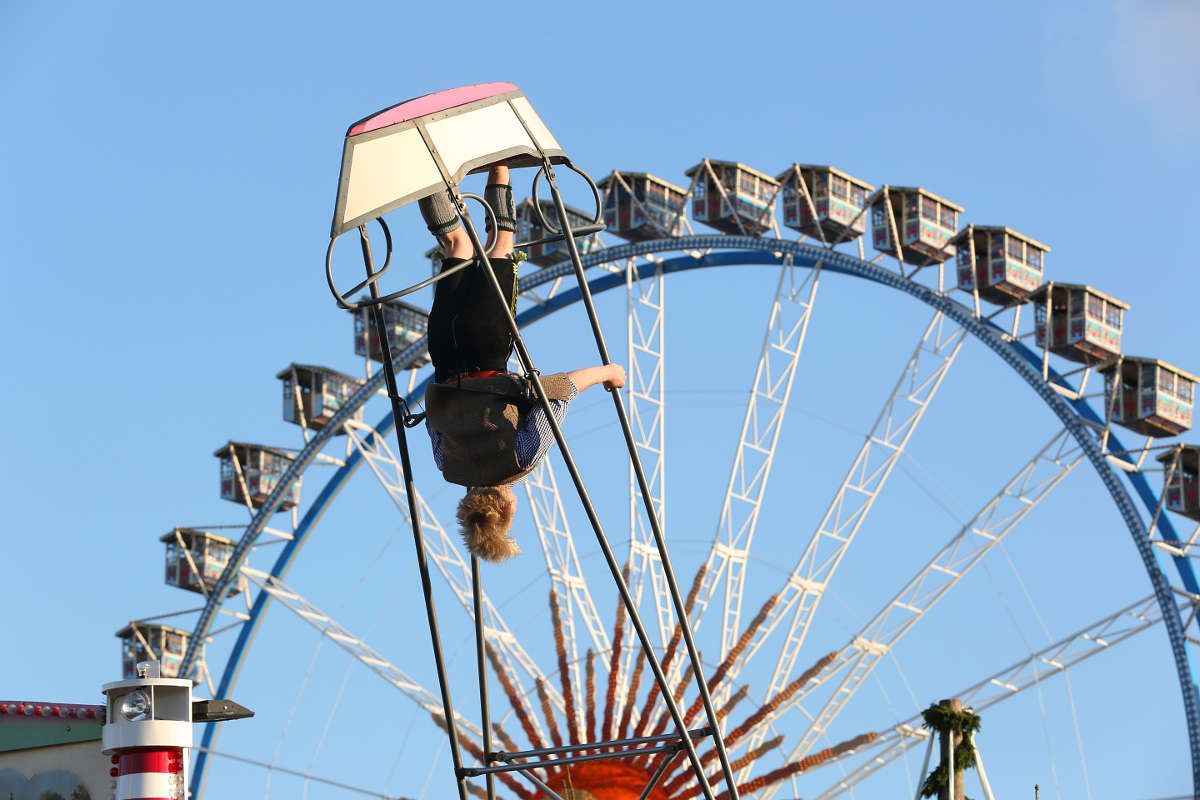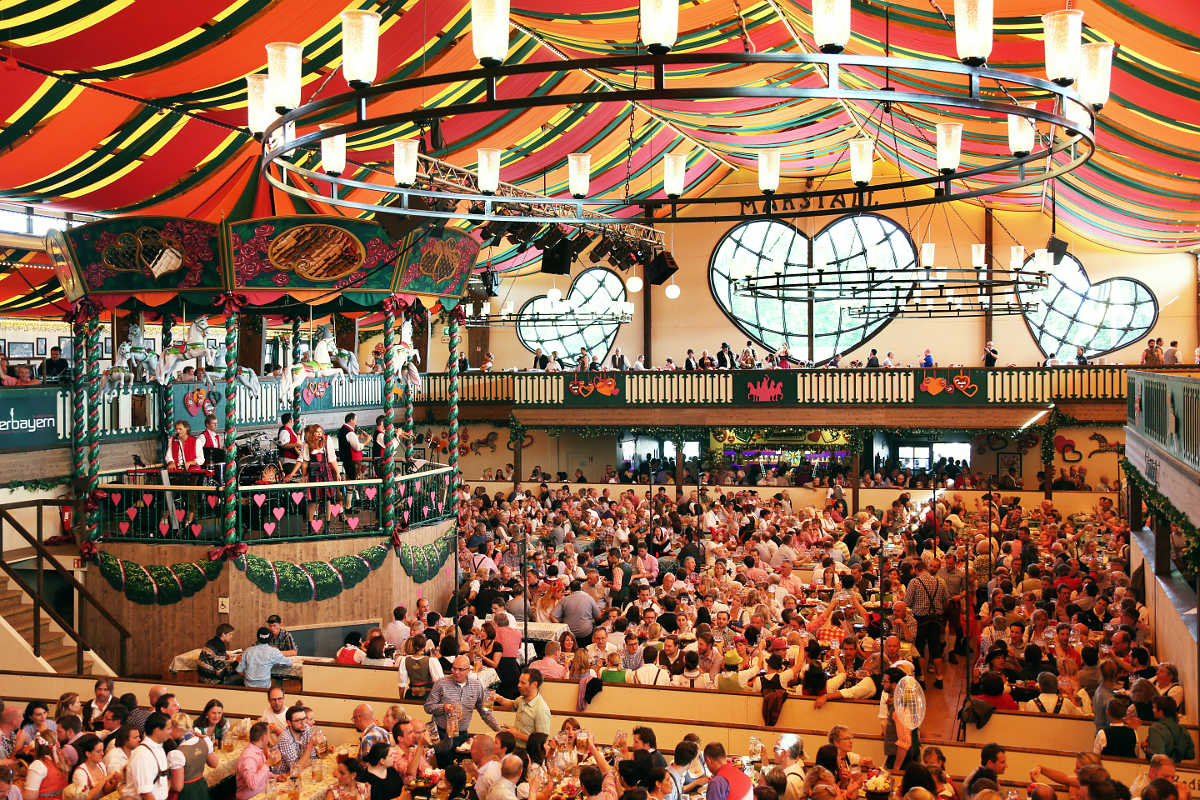On Saturday, September 16th, 2023 at high noon sharp Munich’s Lord Mayor – once again ceremonially exclaimed: ‘It’s tapped!’ The Oktoberfest, a festival recurring for the 186th time, has been exerting its magnetism on the crowds since 1810. It means huge fun for regular folks, works as an illustrious place-to-be-seen for celebrities of all shapes and sizes and could even enhance or jog a career of one trade or another. And it serves as a welcome runway for the presentation of suitably traditional garb (such as Dirndl, Lederhos’n or Lodenjanker) – or for a rare species of couture whose daring cross-over creations are at times hard to swallow for the more conservative.

Young Bavarians clad in their traditional garb. Photo: ©Frank Bauer
Visitors flock in by the millions for the abundance of attractions in stock – the Ferris Wheel, the rollercoasters, merry-go-rounds, the scooters, shooting stands or swing boats, for the food and for drinking beer by the liter. Whereby „liter“ in terms of „one“ is not the mode in which the steadfast Oktoberfest-goer usually operates: They want it all – and they want it now – even though the “Mass” holding this one liter is not to be had below 10 euros. One doesn’t leisurely sip at a beer, one gulps it down – if there is any stamina at all to be shown off! And those mugs are heavy, mind you! Just ask the waitresses!

A swing boat is nothing for a sensitive stomach … Photo: ©Sigi Müller
Conquering vast amounts of the frothing yellow beverage quick often renders people more gregarious than they already are and culture gaps are bridged in the blink of an eye. A lifted mood could well be marred by a splitting headache and an angrily heaving stomach, should the happy-go-lucky folk festival-consumer have missed to put a stop to the constantly replenished reservoir set up to reliably quench his or her thirst. After a bacchanal, intentional or not, hungover incorrigibles might wake up in a hospital ward with their gingerbread hearts still around their necks or be groaning within the confines of a sobering-up cell. Both locations pose but a last resort for a minority while disciplined demeanour largely prevails on the fair grounds.
Bavarian fare galore
Nibbling at crisp giant pretzels or digging into Knöd’l, Eisbein or a hearty Jaus’n with relish while listening to swinging brass bands – or jollily singing, swaying and dancing along – is what the Oktoberfest is all about. The blissful atmosphere is contagious for sure and those not able to travel to Munich, have cultivated their own ilk of felicitous oktoberfesting.

Fellows in instruments: a typical traditional brass band entertaining the crowds. Photo: ©Frank Bauer
Munich is beyond reach? Oktoberfests work everywhere!
Oktoberfests, large or small and definitely varying in authenticity, are being organised the world over, and nations least relatable to idiosyncratic alpine gusto and tradition – such as Arabia, China, Japan or the Philippines, just to name a few – seem to develop the greatest deal of joy with it on their own territory. Often clad in bespoke outfits and seated at checker-clothed tables, a happy occasion is celebrated with maximum dedication and the frequent release of a rehearsed yodeller a liberating therapy for the stressed cosmopolite. And nothing can deter an internationally thinking Beijinger from indulging in their Paulaner beer freshly brewed at a five-star hotel in the Chaoyang district – along with smoked ribs, sausages, steaming Sauerkraut and fragrant pretzels straight from the oven. But that’s a steady institution, a daily sino Oktoberfest-light, so to say.
How the Oktoberfest came about
When Crown Prince Ludwig (later to become King Ludwig I), wed Princess Therese of Saxony-Hildburghausen on 12th October 1810, all of Munich’s citizens were invited to join the frolicsome party. The festivities held on an open area outside the city gates – the Theresienwiese – were concluded by horse races which again took place in the subsequent year. To boost farming activities in Bavaria, an agricultural show was added to the programme. Et voilà: the forerunner of the Oktoberfest was born. Albeit amusement-wise, options were still slim: one lonely carousel and two meagre swings by 1818, sidelined by some beer stalls scattered on-site. Supported by local breweries, wealthy landlords had put up first beer tents and halls by 1896 and from there the success story Oktoberfest started to unleash its powerful potential. Today, it is testified as being the world’s largest festival welcoming around six million annual visitors flocking in from all four corners of the globe. And in all likelihood, it is also the most vividly and unashamedly-copied event on the face of this planet.
Magnificent Oktoberfest overtures

Brewery horses made up for the colourful parade. Photo: ©B. Roemmelt
Descendants from the original landlords and brewery owners plus their families are the protagonists of the overture before the festival’s official opening. On September 17th, some 1,000 participants, decorated carriages and floats, splendidly adorned horse-drawn brewery drays and the beer-tent bands will show themselves in a 45-minute procession starting at Sonnenstraße. The next day, the Costume and Riflemen’s Parade involving around 9,000 performers are parading over a seven kilometer stretch: A procession of groups in regional costumes, “troops” in historical uniforms, said riflemen, marching bands, thoroughbred horses, oxen, cows, goats, the decorated drays of the Munich breweries, floats displaying typical local traditions and historic carriages all pass by.

Dress and ladies bearing the same name: Dirndl. Photo: ©Frank Bauer
- Wies’n – is the Bavarian way of pronouncing „Wiese“ (wi:sə = a meadow).
- Zuagroaster – (tsu’agroastə) – non-locals
- Saupreiss – (sowprice) – every non-Bavarian on the planet
- Festzelt – the tent on a fair site like the Oktoberfest’s (z = t͡s)
- Mass – the traditional beer mug that contains one liter of liquid
- Schunkeln – linking arms to sway (and sing) along with the music
- Schuhplattler – (u as in shoe) – a folk dance where performers clap the soles of their shoes with their palms while skipping up in the air
- Lebkuchenherz – (lɛbˈkuːxənhɛrts) a gingerbreadheart heavily decorated with sweets and writing in icing sugar
- Knöd’l – (knœdl) – a dumpling
- Eisbein – (icebine) a leg of pork
- Jaus’n – (ya’ʊsn) a snack, mostly consisting of ham, sausage, cheese, bread, and perhaps some radish
- Dirndl – (i as in fit) the traditional dress ladies wear in alpine regions. It allows them to display their female loveliness pushed up over the low-cut rim of a generous neckline. Dirndl also simply means “girl”.
- Lederhosn – (lɛdəho:sn – s + p) robust trousers made of leather featuring a buttoned front (the legendary „Hosenstall“) often embroidered for beautification. The more worn, the more treasured Lederhos’ns become. Some – now soft and shiny – have been passed on over generations.
www.muenchen.de/int/en/events/oktoberfest
Header image: ©Tommy Loesch All photo footage courtesy of München Tourismus

